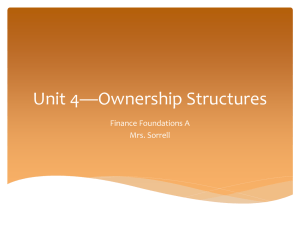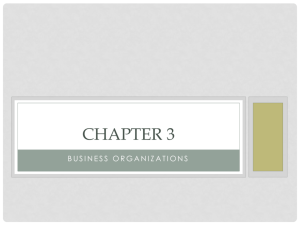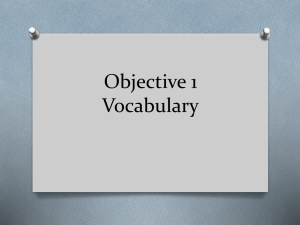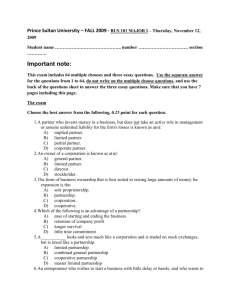A. Reading BUSINESSS
advertisement
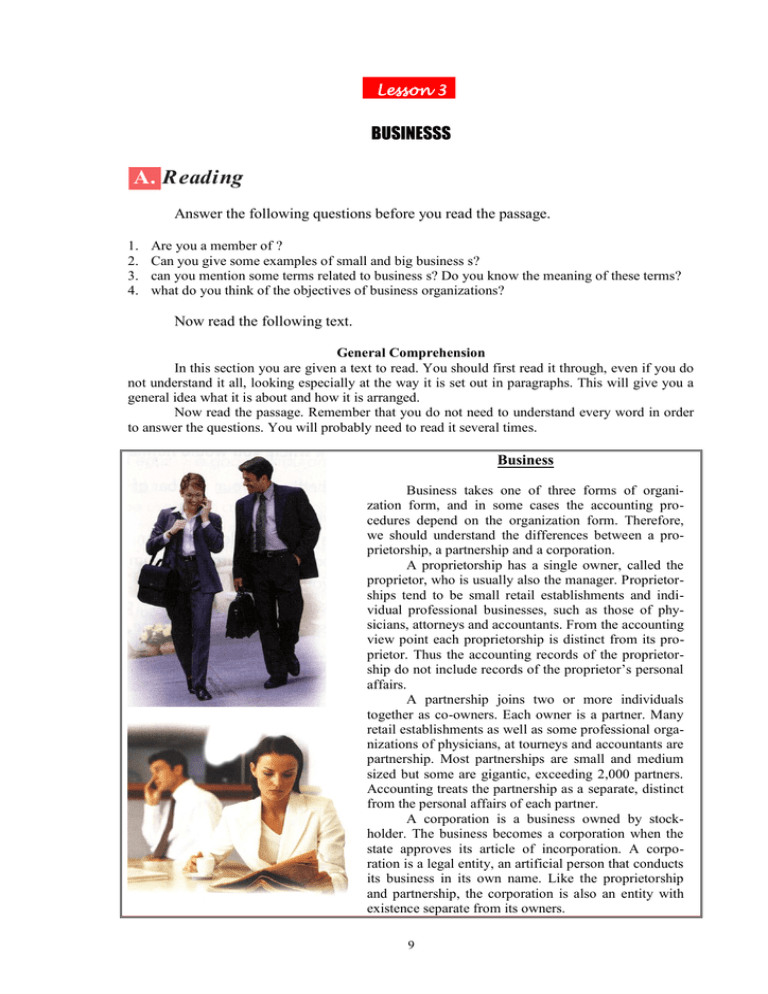
Lesson 3 BUSINESSS A. Reading Answer the following questions before you read the passage. 1. 2. 3. 4. Are you a member of ? Can you give some examples of small and big business s? can you mention some terms related to business s? Do you know the meaning of these terms? what do you think of the objectives of business organizations? Now read the following text. General Comprehension In this section you are given a text to read. You should first read it through, even if you do not understand it all, looking especially at the way it is set out in paragraphs. This will give you a general idea what it is about and how it is arranged. Now read the passage. Remember that you do not need to understand every word in order to answer the questions. You will probably need to read it several times. Business Business takes one of three forms of organization form, and in some cases the accounting procedures depend on the organization form. Therefore, we should understand the differences between a proprietorship, a partnership and a corporation. A proprietorship has a single owner, called the proprietor, who is usually also the manager. Proprietorships tend to be small retail establishments and individual professional businesses, such as those of physicians, attorneys and accountants. From the accounting view point each proprietorship is distinct from its proprietor. Thus the accounting records of the proprietorship do not include records of the proprietor’s personal affairs. A partnership joins two or more individuals together as co-owners. Each owner is a partner. Many retail establishments as well as some professional organizations of physicians, at tourneys and accountants are partnership. Most partnerships are small and medium sized but some are gigantic, exceeding 2,000 partners. Accounting treats the partnership as a separate, distinct from the personal affairs of each partner. A corporation is a business owned by stockholder. The business becomes a corporation when the state approves its article of incorporation. A corporation is a legal entity, an artificial person that conducts its business in its own name. Like the proprietorship and partnership, the corporation is also an entity with existence separate from its owners. 9 Business 10 From a legal standpoint, however, corporation differ significantly from proprietorships and partnerships. If a proprietorship or a partnership cannot pay its debts, lender can take the owner’s personal assets to pay the debts. But if a corporation goes bankrupt, lender cannot take the personal assets of the stockholders. The limited personal liability of the stockholders for corporate debts partially explains why corporations are the dominant form of business. People can invest in corporations with limited personal risk. Another factor in corporate growth is the division of ownership into individual shares. Companies such as coca-cola, Goodyear Tire, and IBM have millions of shares of stock. An investor can become an owner by buying 30, 100, 5000, or any number of shares of stock. For many corporations, the investor can sell the stock whenever he wishes. It is usually harder to sell out a proprietorship or a partnership. (Adapted from Accounting 2nd Edition by Horngren & Harrison: p.10) Exercise 1 Answer the following questions based on the text. 1. What is a sole proprietorship? 2. What are the characteristics of proprietorship? 3. What are the weaknesses of proprietorship? 4. What are the advantages of corporation? Explain! 5. How does transfer of ownership happen in a corporation? Exercise 2 Determine whether the following statements are true or false. Write T if it is true and F if it is false. Then correct the false statements. 1. _____ The text is about the similarities of the three forms of business organization. 2. _____ All small business are proprietorship. 3. _____ The members of partners in partnership are very considerably. 4. _____ Both proprietorship and partnership are treated separately from their owners. 5. _____ Ownership in a corporation is represented by shares of stock. 6. _____ Owners of proprietorships and partnerships have more limited liability than stock holders. 7. _____ Stock holders have higher risk of losing their personal assets than proprietorships. 8. _____ Stock holders may have different members of shares in a company. 9. _____ It is easier to sell shares of stock than to sell out a proprietorship. 10. _____ It is easier to raise fund or capital in a corporation than a partnership or proprietorship. Exercise 3 Classify the types of business organizations and write the report. You may do it now, or you may take it as a homework. It is good to do this task in groups. Never stop learning; knowledge doubles every fourteen months. Business 11 B. Vocabulary Exercise 1 Put the suitable word, partnership, proprietorship or corporation in the right side of the following business organization: 1. 2. 3. 4. 5. 6. PT Indofood Sukses Makmur Fa. ABC Toko Aria CV Andalas Hotel Carissa Salon Ananda Exercise 2 Fill the empty space with the appropriate words forms related to the provided words. No 1. Verb 2. differ Noun distinction Adjective Meaning organization 3. legal 4. 5. establish 6. profess dependence 7. 8. dominant 9. growing separate 10. Exercise 3 1. 2. 3. 4. 5. Write your own sentence using each of the following words. retail approve debt bankrupt hard If you study to remember, you will forget; if you study to understand, you will remember. Business 12 C. Grammar Noun Phrase Look at the noun phrase legal entity. The head of this noun phrase is entity. It is a noun. Legal is an adjective. It tells about entity. This noun phrase is often explained as follows: legal entity Adjective Noun Head Exercise Find the noun head and the adjective in each of the following noun phrases. 1) accounting procedures 2) single owner 3) individual professional businesses 4) personal affairs 5) small and medium sized 6) artificial person that conducts its business in its own name 7) limited personal liability 8) corporate growth
